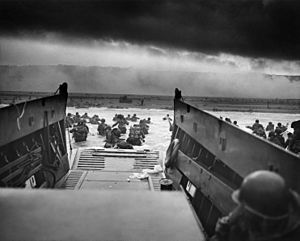Omaha Beach facts for kids
Quick facts for kids Omaha |
|||||||
|---|---|---|---|---|---|---|---|
| Part of the Normandy landings, World War II | |||||||
 Into the Jaws of Death: Troops from the U.S. 1st Infantry Division landing on Omaha, as photographed by Robert F. Sargent |
|||||||
|
|||||||
| Belligerents | |||||||
| Commanders and leaders | |||||||
| Units involved | |||||||
|
|
||||||
| Strength | |||||||
| 43,250 infantry 2 battleships 3 cruisers 13 destroyers 1,010 other vessels |
7,800 infantry 8 artillery bunkers 35 pillboxes 4 artillery pieces 6 mortar pits 18 anti-tank guns 45 rocket launcher sites 85 machine gun sites 6 tank turrets |
||||||
| Casualties and losses | |||||||
| 2,000–5,000+ | 1,200 | ||||||
Omaha, commonly known as Omaha Beach, was the code name for one of the five sectors of the Allied invasion of German-occupied France in the Normandy landings on June 6, 1944, during World War II. "Omaha" refers to an 8-kilometer (5 mi) section of the coast of Normandy, France, facing the English Channel, from east of Sainte-Honorine-des-Pertes to west of Vierville-sur-Mer on the right bank of the Douve River estuary.
Landings here were necessary to link the British landings to the east at Gold with the American landing to the west at Utah, thus providing a continuous lodgement on the Normandy coast of the Bay of the Seine.
Taking Omaha was to be the responsibility of United States Army troops, with sea transport, mine sweeping, and a naval bombardment force provided predominantly by the United States Navy and Coast Guard, with contributions from the British, Canadian and Free French navies.
The primary objective at Omaha was to secure a beachhead eight kilometers (5.0 miles) deep, between Port-en-Bessin and the Vire River, linking with the British landings at Gold to the east, and reaching the area of Isigny to the west to link up with VII Corps landing at Utah. The untested American 29th Infantry Division, along with nine companies of U.S. Army Rangers redirected from Pointe du Hoc, assaulted the western half of the beach. The battle-hardened 1st Infantry Division was given the eastern half.
Opposing the landings was the German 352nd Infantry Division. Of its 12,020 men, 6,800 were experienced combat troops, detailed to defend a 53-kilometer (33 mi) front. The German strategy was based on defeating any seaborne assault at the water line, and the defenses were mainly deployed in strongpoints along the coast.
The Allied plan called for initial assault waves of tanks, infantry, and combat engineer forces to reduce the coastal defenses, allowing larger ships to land in follow-up waves. But very little went as planned. Difficulties in navigation caused most of the landing craft to miss their targets throughout the day.
The defenses were unexpectedly strong, and inflicted heavy casualties on landing U.S. troops. Under heavy fire, the engineers struggled to clear the beach obstacles; later landings bunched up around the few channels that were cleared. Weakened by the casualties taken just in landing, the surviving assault troops could not clear the heavily defended exits off the beach. This caused further problems and consequent delays for later landings.
Small penetrations were eventually achieved by groups of survivors making improvised assaults, scaling the bluffs between the most heavily defended points. By the end of the day, two small isolated footholds had been won, which were subsequently exploited against weaker defenses further inland, achieving the original D-Day objectives over the following days.
Images for kids
-
2nd Infantry Division troops and equipment going up the bluff via the E-1 draw on D+1, June 7. They are going past WN-65 that defended the route up the Ruquet Valley to Saint-Laurent-sur-Mer.
See also
 In Spanish: Playa de Omaha para niños
In Spanish: Playa de Omaha para niños















